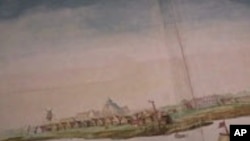Four hundred years ago this month, Henry Hudson, looking for a sea route to Asia, sailed into what is now New York Harbor. His arrival is celebrated as the beginning of Dutch settlement in North America. A few years later, Dutch traders established New Amsterdam to trade animal furs with local Indians. Today that settlement is known as New York City.
New York City has such a distinctive look it's hard to imagine it was once a small Dutch settlement.
But at New York's South Street Seaport Museum, a centuries-old document proves the Dutch did indeed pay for this land.
Martin Berendse, the Director of the Netherlands National Archives, translated the letter, written by a Dutch official in 1624.
BERENDSE: "All mighty lords of the State General. I heard a ship, the New Amsterdam, came in from New Netherlands to Amsterdam. I spoke to the captain and he told me. Our people are doing well. Children are born. The settlement is going good. And we bought the island of Manhattan for the worth of 60 guilders. By the way the ship has so many furs with it."
The letter is on loan from the Netherlands for New York's 400th anniversary.
"It's the testimony of the creation of a Dutch settlement called New Amsterdam which now became the big city of New York," explained Berendse.
A map of the area is also on display, showing houses and roads at the new settlement.
Another shows just how small Manhattan was. That changed after the British took over.
Architectural historian Barry Lewis says the British filled in part of what's known as the East River with garbage because they needed the real estate. Waves of immigrants, mostly from Europe, kept on coming.
"We had only about 100,000 people at the beginning of the 19th century," he said. "By 1875 the population of Manhattan is over one million. By 1910, over 2 million people are living in Manhattan Island."
Manhattan real estate became expensive. In 1883, the Brooklyn Bridge was built so people could buy land, further out, on Long Island where it was cheaper.
"You could go across by carriage, freight or passengers. You could walk across," added Lewis.
Then came the subway.
"The brilliance of the New York subway system is that for one nickel it took you miles and miles away from the central business district and opened up cheap real estate in the outlying parts of the metropolitan area. So the average person could at least afford a house, an apartment a nice place," Lewis explained.
But businesses needed to be in Manhattan. So developers started building up, and the skyscraper was born.
"People were afraid it would fall down in the first windstorm," said Lewis. "And anyone who had property in the commercial buildings next to it they were terrified that no one would rent in their buildings because that thing was next door."
But more of 'those things' rose. The Woolworth Building, the Chrysler Building. The Empire State Building. Each one outdoing the other.
"It's money, lets face it. This is a city built by real estate speculators," said Mr. Lewis.
But that's not why everything in New York was built.
The Washington Square Arch designed by Stanford White and the Guggenheim Museum by Frank Lloyd Wright, among other buildings, have enhanced New York's architectural landscape.
Still that small sliver of land that began 400 years ago as a trading post is today still about money.
The area the Dutch settled to trade furs with the Indians is now Wall Street, the world's financial center.






